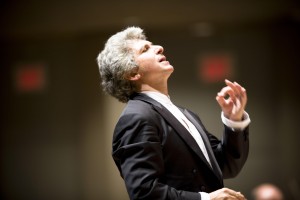
Peter Oundjian, previously of the Tokyo String Quartet, turned to conducting after focal dystonia ended his career as a violinist
In “Focal Dystonia in Musicians, Part 1,” we introduced the disorder and presented its symptoms. In “Part 2,” we discussed treatment options specific to musicians. In this final installment, we will address strategies designed to help musicians prevent focal dystonia.
Preventing Focal Dystonia: What a Musician Can Do
Focal dystonia is much easier to prevent than to treat. Even after therapy, many musicians with focal dystonia are forced to find other careers or turn to teaching or conducting to stay within the field of music. A study by Jabusch & Altenmüller found that only 54 percent of their musician patients with focal dystonia had improved after eight and a half years of treatment. [1] In light of the often devastating and life-altering effects of focal dystonia and other performance-related injuries, for musicians, prevention is key.
Strategies: An Ounce of Prevention
Awareness: Musicians should be aware of any tension in their bodies while they play. If you have difficulty sensing this tension, or aren’t sure how to address it, consider exploring the Feldenkrais Method or Alexander Technique to learn how to play in a more relaxed manner.
Balance: Achieve a balance between repertoire and rehearsal schedules. Try not to schedule rehearsals back to back, and spread out your playing time throughout the day.
Rest: Take breaks during practice sessions, and rest when your body is fatigued.
Self-realization: Understand that perfectionist behaviors can increase a musician’s stress level and tend to foster unhealthy practice habits. [2] These behaviors should be addressed effectively, with a professional’s help.
Gradual Change: Avoid sudden increases in playing intensity or length. Teachers should also be careful when adjusting their students’ playing techniques, as abruptly changing a long-standing movement pattern may trigger the onset of dystonia. [3]
Actively adopting these strategies can help avoid performance-related injuries, including that of focal dystonia.
Summary
Many musicians fail to respond to standard treatments for focal dystonia, and may require numerous years of therapy before they are able to resume their careers, if they are fortunate enough to recover from the disorder. Focal dystonia may be rare, but its onset and persistence can be catastrophic for a musician whose chosen career involves playing his instrument for his livelihood. Despite the recent advances that have been made in the treatment of focal dystonia, more research must be conducted to improve the success rates of current treatments, and to explore new methods of therapy for this debilitating and life-altering disorder.
Musicians: Please keep in mind that focal dystonia is very rare, even though it does occur. As always, visit a physician for an appropriate diagnosis if you think you may be experiencing an injury, since many conditions have similar symptoms but very different treatments and outcomes.
References
[1] Jabusch H-C, & Altenmüller, E. (2006). Focal dystonia in musicians: from phenomenology to therapy. Advanced Cognitive Psychology, 2(2-3), 207-220.
[2] Jabusch H-C, & Altenmüller, E. (2004). Anxiety as an aggravating factor during onset of focal dystonia in musicians. Medical Problems of Performing Artists, 19(2), 75-81.
[3] Brandfonbrener, A.G. (1995). Musicians with focal dystonia: a report of 58 cases seen during a ten-year period at a Performing Arts Medicine clinic. Medical Problems of Performing Artists, 10(4), 121-127.














It is also important to become nutritionally knowledgeable. This goes beyond the balanced diet and vitamins. What dietary lifestyle fits your life. If you have focal dystonia, or are trying to avoid its onset, look at FD for what it is…a neurological malady meaning you should make sure of your neurological support. Some things you should be aware of is the ketogenic diet has been shown worthy of praise from the medical world in treating neurological illnesses such as epilepsy and parkinsons disease. Make sure that your vitamin B12 and vitamin D levels are optimal, not just satisfactory but OPTIMAL.
i have done much research into the development of stylistic personality in musicians and how, with certain personalities, private practice becomes a defence against emotions thus creating unconscious compulsive practice habits making them ripe for focal dystonia. the area of the body effected depends on the reason for the development of the aforementioned.
Excellent post.
Awareness, balance and rest are all vital ingredients in preventing Musician’s Focal Dystonia. Body mechanics, mental direction/intention and emotions are what I believe to be the 3 key or core parts to both preventing and resolving MFD.
Jon Gorrie